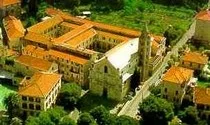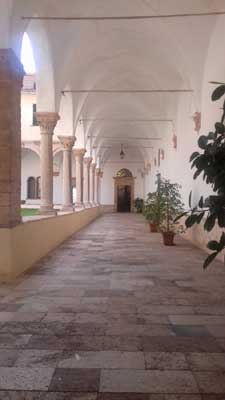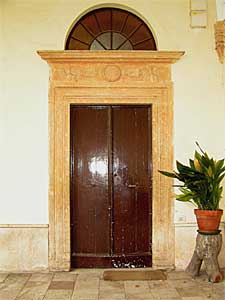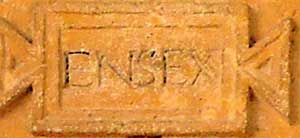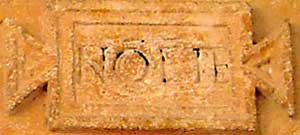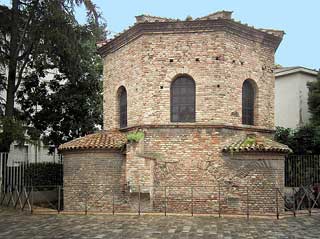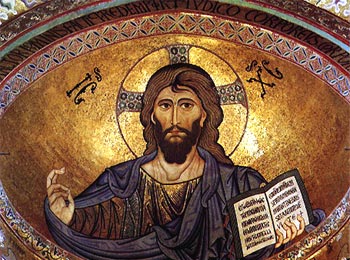fra angelo
Documents
Fra'Angelo of Albenga
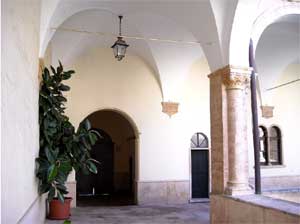
We also know that, in the years following 1533, the Olivetan monks had extended our church up to 35 meters. This length also corresponds to the last pillar of the south wing of our cloister (the one adjacent to the church), with the date (1563) engraved on it.
Now we want to examine the entrance door of the monastery that can be seen at the bottom of the south wing of the cloister, seen from Piazza Abbazia.
It is said that above this door there was a painting that celebrated the munificence of the Marquises Del Carretto for having built this Olivetan monastery next to the Sanctuary.
Unfortunately in 1799 the Olivetan monks were driven out (from morning to evening) by Napoleon's troops and this monastery was occupied by the French military. Then, again in 1800, the Piedmontese succeeded the French.
Meanwhile, the functioning of our parish church was ensured by various priests, some diocesans and other religious.
Finally in 1905 our family of Sublacense Benedictine monks arrived permanently.
Thus, for more than 100 years, no one had taken care of that celebratory painting that was located above the entrance to the building, which in the meantime must have deteriorated somewhat.
It is known that the dust swept under the carpet is no longer seen, but it remains!
Who knows if someone - one day - reading these lines will think of recovering it (the painting, not the dust ...), removing the various layers of plaster that have covered it in the meantime, and will take care of an adequate restoration .... !
This painting, properly restored, could turn out to be a very interesting work.
The Marquises Del Carretto were not an insignificant noble family, but they were Electors of the Emperor of the Holy Roman Empire of Germany and were part of the chosen Aristocracy of the Empire.
A painting that was supposed to celebrate them could not have been something banal to be entrusted to any improvised artist.
Such a recovery could prove, in many respects, a more than stimulating undertaking!
Now let's leave the paint under the layers of plaster on the back wall and, going down a little below, let's start examining the ornament above the entrance door.
In the center, surrounded by a stately garland, we see the famous Monogram of Saint Bernardino of Siena IHS.

Those who reproduced this Monogram have added (as often still happens) the figure of a Cross (+) above the horizontal rod of the central H. This addition has complicated the reading, helping to create the most imaginative and hyperbolic interpretations of the meaning of the Monogram itself.
Our history scholar P. Gregorio Penco argued that the addition of the cross was completely arbitrary and that the three letters (IHS) are the original ones, chosen by San Bernardino; they belonged neither to the Latin alphabet nor to the Italian one, but to the Greek alphabet.
The first and third letters (I - S) are identical to the same Italian letters and are pronounced as they are used in Italian. The central letter (H) is Greek and corresponds to the Italian E.
So the correct pronunciation of the monogram is IES (sound corresponding to the well-known English yes)
These three letters would be none other than the first three letters of the Latin name of Jesus: IESUS.
As used in monograms, this is a concise graphic sign, consisting of just three letters, which is intended to help us recall the Lord in our minds and hearts.
Gregorio Penco was a Genoese DOC and as such he did not like frills, but he preferred practical things, dictated by common sense.
ARIO
It is easy for the Latin expressions, which are in the two tablets to the left and to the right of the garland with the Monogram, to escape the attention of a visitor who is ignorant of Latin or who has a superficial knowledge of it.
We will try to help by reporting the words clearly and explaining their interesting meaning.
Before continuing, however, it should be noted that these two expressions were the work of ARIO, an ancient and famous character.
Ario was the name of a priest who gave rise to a deadly heresy for the Catholic Church of the first centuries. (For more information you can consult Wikipedia).
We will see the reason for the presence of these expressions of a heretic on the door of our Monastery.
On the left tablet it is clearly written: ENS EX.
We need to work a little on what is written on the tablet on the right.
We only read a sentence in abbreviated form: NO E TE
But if you look carefully you will notice that there are 3 dashes: one on the O another on the following E, the third on the TE. The dashes indicate that, for reasons of space, some letters have been omitted.
The O is missing an N, the E is missing an X and finally the TE has even 2 initial letters EN omitted.
Therefore on the right tablet it should have been written: NON ENTE.
But the limited space dictated those abbreviations that we have tried to explain.
SUMMING UP
E N S E X – N O E T E (the 2 original texts)
ENS EX – NON ENTE (the 2 original texts developed)
These expressions refer to Jesus and date back to the Arian disputes of the fourth century.
For Ario these expressions meant that Jesus came from nothing (Ens ex non ente), and that therefore he could only have been created
On this door, however, the expressions are understood in an orthodox sense for the Christian faith: Jesus does not come from nothing, because he is eternal.
Ario knew how to enchant with words and managed to be so convincing that even Catholic bishops ended up considering his reasoning more than plausible.
Thus an Arian church arose, self-styled Christian.
In Wikipedia you can get an idea of the influence of Arianism.
Ario did not deny the Most Holy Trinity, but said that the Son was not God at all, but only an exceptional man, favored by such extraordinary abilities, as to be able to overcome death and become immortal.
In the first centuries after Christ, Christianity spread in a pagan world and the ancient pagan religion included many demigods: characters who, born simple men, had become divinities.
In this world, Ario's message therefore found fertile ground to develop.
But Ario, in addition to being a skilled speaker, knew how to compose beautiful songs based on his doctrine.
Those who love to sing usually prefer the songs they like best.
Thus, in a few years, the voices of the sailors resounded in the ports and on the ships of the Mediterranean basin, accompanying their work precisely with the beautiful songs composed by Ario.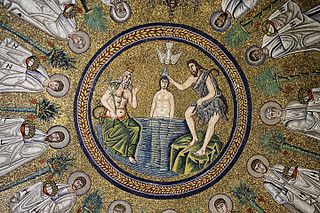

Furthermore, when the barbarians entered the Roman world, it was discovered that many of them were already Arians.
This heresy was so seductive that it still caused problems in the seventh century.
In the cultured and brilliant (in many respects) Renaissance, attempts were made to show off a vast knowledge, even of ancient problems. The sibylline expression, like the one we have examined, seemed appropriate to appear on the door of a monastery, because the problem of a God who becomes man is always alive in all ages. All the more because he did it to die ... for man!
…But even today it is not uncommon to hear a statement on TV (or read in quite a few newspaper articles and also in many books) that Jesus was truly an exceptional man, but not everyone comes to peacefully accept his Divinity.
Yet Jesus was explicit.
"Whoever has seen me has seen the Father" Jn 14:9
"I and the Father are one" Jn 10:30
